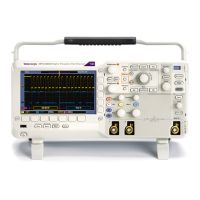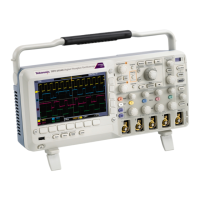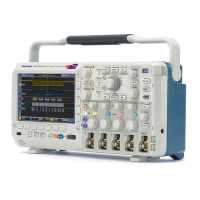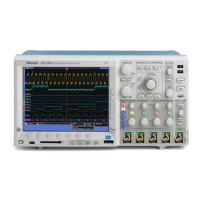Do you have a question about the Tektronix DPO2014 and is the answer not in the manual?
| Bandwidth | 100 MHz |
|---|---|
| Channels | 4 |
| Sample Rate | 1 GS/s |
| Record Length | 1 Mpoints |
| Vertical Resolution | 8 bits |
| Timebase Range | 5 ns/div to 50 s/div |
| Timebase Accuracy | 50 ppm |
| USB Ports | 2 |
| Display Type | TFT LCD |
| Vertical Sensitivity | 2 mV/div to 5 V/div |
| Maximum Input Voltage | 300 V (DC + peak AC) |
| Trigger Types | Edge, Pulse Width, Runt |
| Interface | USB, LAN |
| Input Impedance | 1 MΩ |
| Power Requirements | 100-240 VAC, 50/60 Hz |
| Weight | 4.4 kg (9.7 lb) |
Safety precautions for preventing fire and injury during operation.
Lists the main capabilities and specifications of the oscilloscopes.
Discusses input voltage, power, weight, and dimensions of the oscilloscopes.
Explains how to connect different types of probes to the oscilloscope.
Steps for connecting the oscilloscope and powering it on safely.
Procedure for safely powering off the oscilloscope.
Steps for performing a quick functional check of the oscilloscope.
Instructions for compensating passive voltage probes for accurate measurements.
Overview of the buttons and controls on the oscilloscope's front panel.
Instructions on how to navigate and use the oscilloscope's menu system.
Explains various buttons and knobs for controlling waveforms and cursors.
Knob for adjusting trigger point location relative to waveforms.
Knob for adjusting the horizontal scale (time/division).
Knob to adjust the trigger level for stable triggering.
Knob for adjusting the vertical position of waveforms.
Knob for adjusting the vertical scale factor of waveforms.
Button to power the oscilloscope on or off.
Button to restore the oscilloscope to its default settings.
Inputs for analog channels with TekVPI probe interface.
Signal source for probe compensation.
AC power input connection.
Procedures for setting up analog channels to acquire signals.
How to set parameters for serial and parallel buses.
Procedures for setting up digital channels on MSO2000 models.
How to use FilterVu to reduce unwanted noise and capture glitches.
Explains the fundamental concepts of triggering on signals.
How the oscilloscope behaves in the absence of a trigger event.
How slope and level controls determine trigger point on a signal.
How to select the desired trigger type from a list.
Explains trigger conditions for different trigger types.
Triggering on various bus conditions.
How to trigger on various bus types with application modules.
How to quickly determine key trigger parameter settings.
Procedures for starting and stopping data acquisitions.
How to add or remove waveforms from the display.
How to set waveform display style and persistence.
Using horizontal controls to adjust time base and trigger point.
How to set coupling, bandwidth, probe parameters, and more.
How to position, scale, and group digital channels.
Procedures for taking automatic measurements on waveforms.
Lists and describes automatic measurements by category (time or amplitude).
Lists and describes amplitude measurements like Peak-to-peak and Amplitude.
How to customize automatic measurements using gating, snapshots, or levels.
How to confine measurements to a specific portion of a waveform.
How to use on-screen markers for manual measurements.
How to create math waveforms for analysis.
How to create and use reference waveforms for comparison.
How to use Wave Inspector controls for long record length waveforms.
How to use zoom controls to magnify waveform details.
How to erase setup and waveform data using TekSecure.











